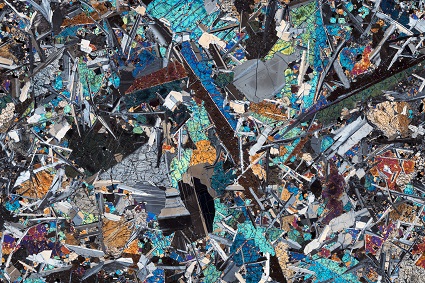Cosmic Microscapes: Seeing Into Rocks From Oregon and Space
March 6, 2021 through July 18, 2021
What do ancient pieces of cooled magma from the Moon and Mars have in common with samples from an eruption of Oregon’s Lava Butte only 7,000 years ago? Examined under a microscope, lava rocks from Earth, Moon, Mars and asteroids have striking similarities–not to mention exceptional abstract beauty. Discover the hidden art of igneous rocks from Oregon and other planets in our solar system in a new Museum exhibit.
This unique exhibition presents fine art imagery of igneous rocks from four sites in the Northwest and elsewhere in our solar system, along with scientific captions detailing their origins, mineral composition and structure. These are the largest photographic prints ever made from petrographic thin sections. Some of the actual rocks, including lunar and Martian samples, will also be on display.
Cosmic Microscapes is a project that marries art and science to reveal the dazzling abstract beauty of meteorites. Small pieces of the Moon, Mars and asteroids were sliced paper-thin and photographed at staggeringly high resolution to produce prints of unprecedented scale. This ongoing project is a collaboration between Seattle photographer Neil H. Buckland and University of Washington professor and meteorite scientist Dr. Tony Irving.
The two met four years ago when connected by a private collector who wanted his extensive meteorite collection catalogued and photographed. After completing the project, Irving sent Buckland a thin slice of rock to photograph for a geology conference. “I looked at it and immediately saw art,” Buckland said. “It was colorful, nuanced, utterly fascinating. I felt that everyone should see this and I became obsessed with capturing every detail in the greatest clarity possible.”
The photographs in this exhibition were captured from glass microscope slides manufactured by Spectrum Petrographics, a specialty lab in Vancouver, Wash., that produces petrographic thin sections for industrial and scientific analysis. The slides contain rock samples which are sliced and polished to a thickness of just 30 microns, about a third of the width of human hair. To the naked eye, such thin sections can appear colorless, nearly transparent, but special lighting reveals a wide range of vibrant colors resembling abstract art.
As an art photographer, Buckland was not satisfied with the image quality produced by a standard scientific microscope and digital sensor. He spent a year building a new system from the ground up with a professional camera at its core and the ability to perfectly stitch hundreds of images together for enormously detailed, large-scale fine art prints.
“Beyond the aesthetic quality and full-immersion visual experience you get from these prints, there’s a scientific advantage to seeing the specimens presented this way,” said Irving, one of the world’s top experts on Martian meteorites. “A geologist looking down the microscope can only see one or two millimeters of the specimen at once. To see more, we move the slide around, but then we lose the context. I’ve looked at thin sections my entire career, but the scale and detail of these prints let us see everything at once, in context like we’ve never seen before. It actually enhances our scientific understanding.”
Click here to discover everything you need to know about your visit to the High Desert Museum!
“The collaboration of Neil Buckland and Dr. Irving has merged art and science in a way that we are excited to explore. With Lava Butte in our backyard, the photographs give us a unique and personal connection to our solar system.”
High Desert Museum Executive Director Dana Whitelaw, Ph.D.

